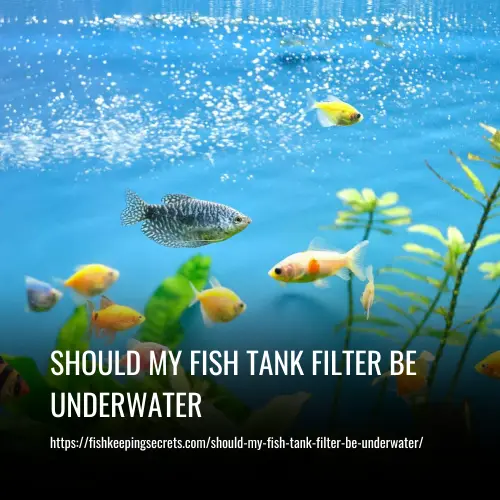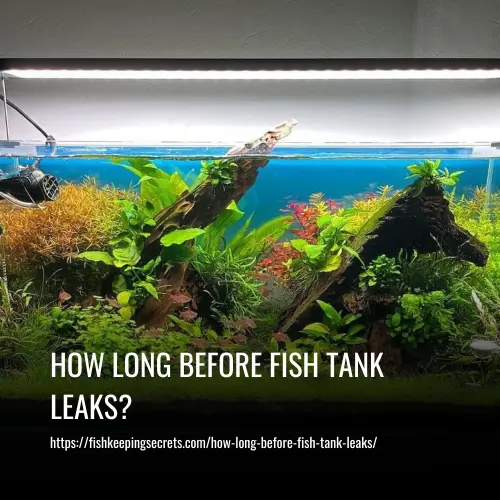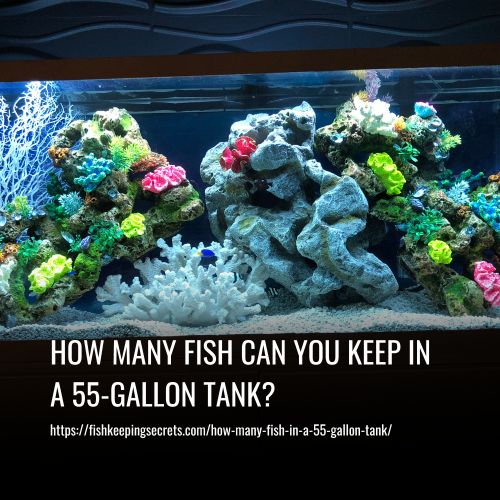Yes, it is recommended to fully submerge a fish tank filter for efficient operation. This allows the filter to draw in water evenly from all areas of the tank, resulting in effective filtration. When the filter is fully submerged, it can effectively trap debris, excess food, and fish waste, keeping the water clean and healthy for your fish.
Partial submersion may lead to inadequate circulation and stagnant areas where waste accumulates. Fully submerging the filter also helps minimize noise caused by splashing or gurgling sounds, creating a more peaceful environment for both you and your fish.

Types of Filters And Their Optimal Positioning
Understanding the different types of filters available for fish tanks and their optimal positioning is crucial for achieving efficient and effective filtration.
1. Hang-on-Back Filters
To maximize the effectiveness of hang-on-back (HOB) filters, they should be positioned with the intake near the water surface. This positioning allows the filter to effectively skim the top layer of water and remove debris and impurities.
2. Canister Filters
Canister filters work best when placed below the tank. By positioning them below the tank, gravity can assist in water flow, creating a more efficient filtration system. This allows water to easily move through the filter media and back into the tank.
3. Undergravel Filters
Undergravel filters are installed beneath a layer of substrate in the tank. They rely on upward water movement through the gravel for filtration. Placing undergravel filters beneath the substrate ensures proper circulation of water throughout the tank, providing effective biological filtration.
4. Sponge Filters
Sponge filters offer versatility in terms of placement within a fish tank. They can be placed anywhere in the tank and provide both mechanical and biological filtration. Sponge filters trap debris and waste particles while also providing a surface area for beneficial bacteria to grow.
Understanding the optimal positioning of each filter type will help ensure that your aquarium has an efficient and effective filtration system, maintaining the health and well-being of your fish.
Pros And Cons Of Fully Submerged Fish Tank Filter
Fully submerging a fish tank filter has its pros and cons that should be considered before making a decision.
Pros
1. Consistent flow rates: Submerging the filter ensures consistent water flow throughout the entire tank volume, resulting in efficient filtration.
2. Effective mechanical filtration: Fully submerged filters have the ability to trap larger particles underwater, leading to better mechanical filtration and cleaner water.
3. Reduced surface disturbances: For some fish species, fully submerged filters create less disturbance on the water’s surface, which can reduce stress levels and create a more natural environment.
4. Aesthetically pleasing: Submerged filters are usually hidden from view, improving the overall visual appeal of the aquarium by keeping the filter out of sight.
Cons
1. Increased cleaning frequency: Fully submerged filters may require more regular cleaning due to debris accumulation underwater, requiring frequent maintenance for optimal performance.
2. Sensitivity of fish species: Some fish may be sensitive to strong water currents created by fully submerged filters, causing discomfort or stress for these specific species.
3. Space limitations: Certain filter types can take up valuable space within the tank when fully submerged, potentially limiting the available swimming area for your aquatic pets.
4. Accessibility challenges: Fully submerging a filter can make it difficult to access and maintain, especially in larger tanks where reaching the filter at the back or sides might be challenging.
Considering these pros and cons will help you make an informed decision about the best filtration system for your fish tank.
Comparison of Submerged vs. Partially Submerged Filters
When deciding on the setup of your fish tank filter, it’s important to consider whether to fully submerge the filter or keep it partially submerged. This decision will have a significant impact on the efficiency of filtration and the overall health of your aquatic environment.
Fully Submerged Filters
1. Consistent and Thorough Filtration: Fully submerged filters provide consistent and thorough filtration by evenly drawing water from all areas of the tank. This ensures that no part of your tank is left unfiltered, promoting the overall cleanliness and health of the aquatic environment.
2. Reduced Noise: Fully submerged filters tend to be quieter compared to partially submerged filters. This can be beneficial for creating a peaceful and calming environment in your aquarium.
3. Unobstructed View: With a fully submerged filter, you’ll have an unobstructed view of your aquarium, allowing you to fully appreciate the beauty of your aquatic life.
Partially Submerged Filters
1. Easy Maintenance and Access: Partially submerged filters can be easier to maintain and access for cleaning. This can save you time and effort when it comes to maintaining the filter and ensuring its proper functionality.
2. Suitable for Gentle Water Currents: Some fish species prefer gentle water currents, and a partially submerged filter can provide this type of flow. It creates a more natural and comfortable environment for these fish.
3. Potential Issues with Water Circulation: One drawback of a partially submerged filter is that it may lead to uneven water circulation. This can result in dead spots where debris accumulates, potentially affecting the water quality and overall health of the aquarium.
Considering these factors will help you determine the best filtration method for your specific aquarium needs. Whether you prioritize thorough filtration and a clear view with a fully submerged filter or prefer easier maintenance and suitability for certain fish species with a partially submerged filter, make a choice that promotes the well-being of your aquatic environment.
Impact of Filter Position on Fish Behavior
The position of your aquarium filter can greatly impact the behavior and well-being of your fish. Fully submerged filters create a consistent water flow throughout the tank, which is beneficial for fish that prefer steady currents. However, for species that prefer calm waters, such as bettas or certain cichlids, a strong current from a fully submerged filter can cause stress.
Partially submerged filters offer a gentler flow, making them a better choice for these sensitive species. By observing your fish’s behavior, you can determine if they are experiencing stress. Signs of stress include erratic swimming, hiding, or reduced appetite. Adjusting the filter’s position or flow rate can help create an environment where your fish can thrive and be happy.
How to Set up an Aquarium Filter
To set up an aquarium filter, start by thoroughly rinsing the filter media to remove any dust or debris. Then, follow the specific instructions provided by the manufacturer for assembly and installation. Make sure to securely connect hoses or tubing to prevent leaks.
If your filter requires priming, fill it with water to remove air pockets before turning it on. By following these steps and manufacturer recommendations, you can create a clean and healthy environment for your fish.
How Should You Know if The Filter is Working
Ensuring that your filter is working properly is crucial for maintaining a healthy aquarium. Here are some signs that indicate your filter is functioning as it should:
1. Consistent Water Flow
Observe the water flow from the outlet of the filter system. There should be a steady and continuous flow of water. If you notice weak or intermittent water flow, it suggests a problem with the filter.
2. No Unusual Noises
A properly working filter operates quietly. Listen for any grinding or rattling sounds coming from the motor or impeller mechanism. Unusual noises can indicate a malfunctioning filter.
3. Stable Water Parameters
Regularly monitor the ammonia, nitrite, and nitrate levels using test kits. These levels should remain within appropriate ranges for a healthy aquatic environment. If the filter is not effectively removing harmful compounds, you may observe consistently high levels.
4. Healthy Fish Behavior
Observe your fish’s behavior. Healthy fish will exhibit active swimming patterns, normal feeding behavior, and vibrant colors. If your fish appear lethargic, refuse to eat, or their colors are fading, it may indicate that the filter is not providing adequate water quality.
5. Clear Water
A properly functioning filter will effectively remove debris and maintain clear water. If you notice excessive debris or algae growth, it could indicate a problem with the filter.
By monitoring these factors, you can determine if your filter is working effectively and take appropriate actions to maintain a healthy aquarium environment.
FAQs
Ideally, filters should be kept underwater since the flow of water into the filter depends on gravity. If the filter is above the water, it may not work efficiently. It is also noisier than when it is underwater because of air entering the filter.
First, determine how many gallons of water your tank holds, then purchase a filter rated for your tank size. Install your filter following the instructions provided, typically placing the filter media inside the filter chamber. Once the filter is operational, monitor the water quality.
Filters should be cleaned regularly, not more than once a month. However, the frequency of cleaning will depend on the bio-load of the tank. Observe your aquarium and clean the filter when necessary, typically when flow has slowed or the water has become cloudy or has an odor.
The depth at which a filter should be placed in a fish tank depends on the type of filter you have. In general, most underwater or submersible filters should be positioned near the bottom of the tank, typically within a few inches from the substrate. It’s important to read and follow the manufacturer’s instructions for your specific filter as requirements may vary.
Yes, sponge filters need to be fully submerged in order to work properly. If they are not completely underwater, they will not be able to effectively filter the water in the aquarium. It’s important to make sure the sponge filter is fully submerged to ensure the best filtration for your tank.
Yes, filter media should be submerged. This is because when the filter media is underwater, it can effectively catch debris and dirt particles. Submerging the filter media also ensures a more even distribution of water flow, leading to improved filtration.
Internal aquarium filters are generally good for filtering small to medium-sized aquariums. They work well for tropical and coldwater aquariums up to 120cm long and 200 litres in capacity. However, they may not be as effective for larger aquariums or for aquariums with large and messy fish like cichlids.
When layering a fish tank filter, it’s important to place the biological media after the mechanical media but before any chemical media. The biological media acts as a substrate for beneficial bacteria colonies, so it should not become clogged. If it does become clogged, the oxygen flow will be restricted, which can lead to the bacteria dying off.
Yes, it is important to always keep the filter on in a fish tank. The filter plays a crucial role in biological, chemical, and mechanical filtration, removing physical and chemical wastes from the water. Additionally, the filter helps oxygenate the water by creating surface disturbance. Turning off the filter can lead to a buildup of waste and decreased oxygen levels in the tank.
It is not recommended to leave the filter off in a fish tank for an extended period of time because it can disrupt the biological balance in the tank. However, if you need to turn off the filter for maintenance or other reasons, try to keep it off for no more than 1-2 hours to minimize any negative effects.
Yes, fish generally need a filter in their tanks to survive. The filter helps to keep the water clean and maintain a healthy environment for the fish. It removes waste, debris, and excess food from the water and promotes the growth of beneficial bacteria that can break down harmful substances.
Yes, even small tanks need a filter. All fish tanks, regardless of size, need to have biological filtration in order to maintain a healthy and balanced environment for the fish.
Conclusion
In conclusion, the placement of your fish tank filter is an important consideration for the health and well-being of your aquatic pets. While it may seem like a matter of personal preference, there are practical reasons to keep the filter underwater. By placing the filter in the water, you can ensure that it is able to effectively remove debris and bacteria, leading to cleaner, healthier water for your fish.
Additionally, submerging the filter can help to reduce noise and maintain a more aesthetically pleasing appearance in your tank. Ultimately, the decision of where to place your fish tank filter should be based on the specific needs of your fish and the overall maintenance of your aquarium.



